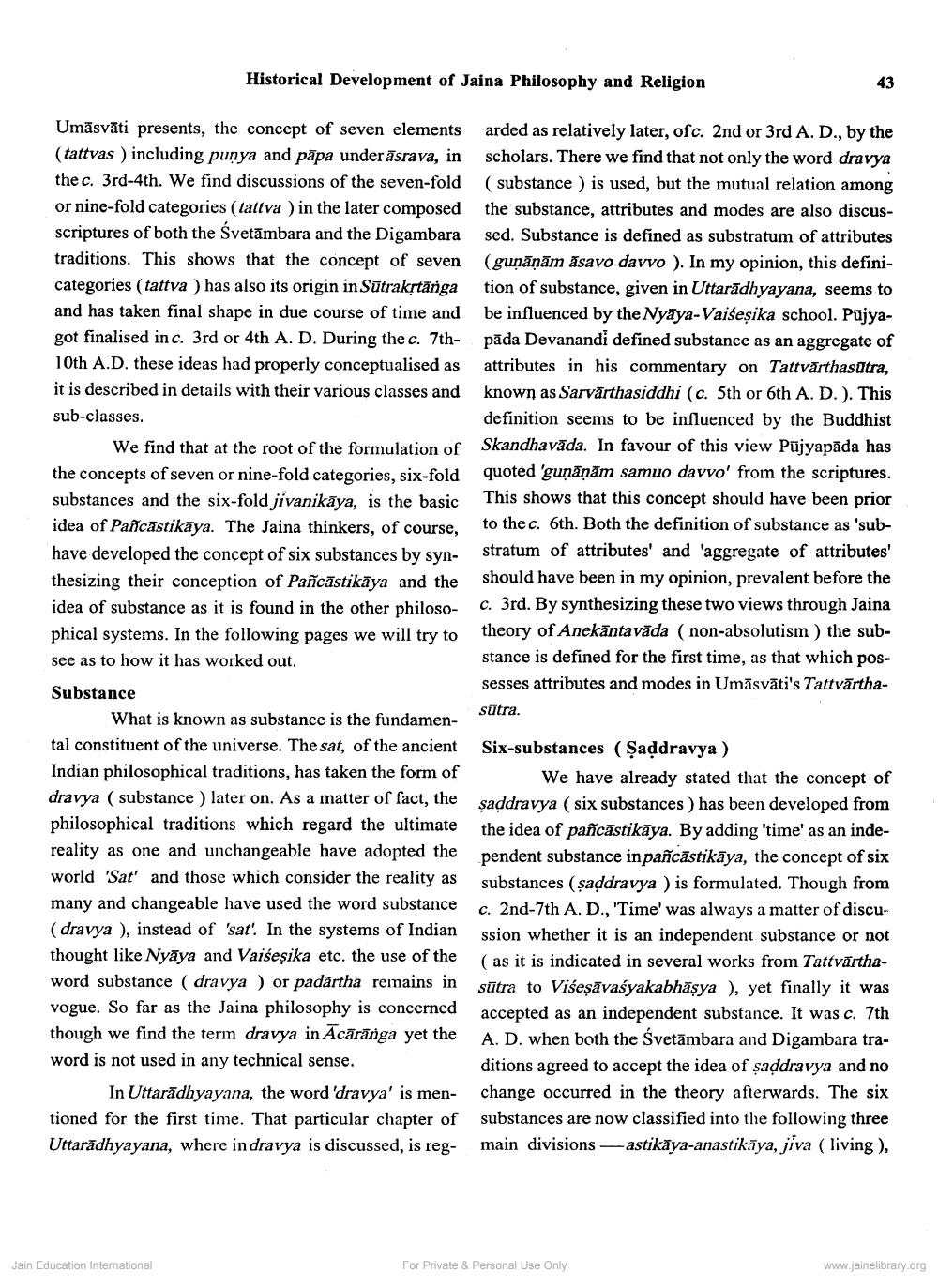________________
Historical Development of Jaina Philosophy and Religion
Umāsvāti presents, the concept of seven elements arded as relatively later, ofc. 2nd or 3rd A. D., by the (tattvas ) including punya and pāpa underäsrava, in scholars. There we find that not only the word dravya the c. 3rd 4th. We find discussions of the seven-fold (substance ) is used, but the mutual relation among or nine-fold categories (tattva ) in the later composed the substance, attributes and modes are also discusscriptures of both the Svetāmbara and the Digambara sed. Substance is defined as substratum of attributes traditions. This shows that the concept of seven (guņāņām āsavo davvo ). In my opinion, this definicategories (tattva ) has also its origin in Sūtrakstānga tion of substance, given in Uttarādhyayana, seems to and has taken final shape in due course of time and be influenced by the Nyāya-Vaišeșika school. Pujyagot finalised in c. 3rd or 4th A. D. During the c. 7th- pāda Devanandi defined substance as an aggregate of 10th A.D. these ideas had properly conceptualised as attributes in his commentary on Tattvārthasūtra, it is described in details with their various classes and known as Sarvărthasiddhi (c. 5th or 6th A. D.). This sub-classes.
definition seems to be influenced by the Buddhist We find that at the root of the formulation of Skandhavāda. In favour of this view Pujyapāda has the concepts of seven or nine-fold categories, six-fold quoted 'guņāņām samuo davvo' from the scriptures. substances and the six-fold jivanikāya, is the basic This shows that this concept should have been prior idea of Pañcastikaya. The Jaina thinkers, of course, to the c. 6th. Both the definition of substance as 'subhave developed the concept of six substances by syn- stratum of attributes' and 'aggregate of attributes' thesizing their conception of Pañcāstikāya and the should have been in my opinion, prevalent before the idea of substance as it is found in the other philoso- c. 3rd. By synthesizing these two views through Jaina phical systems. In the following pages we will try to
theory of Anekāntavāda (non-absolutism ) the subsee as to how it has worked out.
stance is defined for the first time, as that which pos
sesses attributes and modes in Umāsvāti's TattvārthaSubstance
sutra. What is known as substance is the fundamental constituent of the universe. The sat, of the ancient Six-substances ($addravya ) Indian philosophical traditions, has taken the form of
We have already stated that the concept of dravya ( substance ) later on. As a matter of fact, the saddravya ( six substances ) has been developed from philosophical traditions which regard the ultimate the idea of pañcāstikāya. By adding 'time' as an indereality as one and unchangeable have adopted the pendent substance in pañcāstikāya, the concept of six world 'Sat' and those which consider the reality as substances (saddravya ) is formulated. Though from many and changeable have used the word substance c. 2nd-7th A. D., 'Time' was always a matter of discu(dravya ), instead of 'sat. In the systems of Indian ssion whether it is an independent substance or not thought like Nyāya and Vaiseșika etc. the use of the (as it is indicated in several works from Tattvārthaword substance (dra vya ) or padārtha remains in sūtra to Viseşāvasyakabhäsya ), yet finally it was vogue. So far as the Jaina philosophy is concerned
accepted as an independent substance. It was c. 7th though we find the term dravya in Ācārānga yet the A. D. when both the Svetämbara and Digambara traword is not used in any technical sense.
ditions agreed to accept the idea of saddravya and no In Uttarādhyayana, the word 'dravya' is men- change occurred in the theory afterwards. The six tioned for the first time. That particular chapter of substances are now classified into the following three Uttarādhyayana, where in dravya is discussed, is reg- main divisions--astikaya-anastikaya, jiva ( living ),
Jain Education International
For Private & Personal Use Only
www.jainelibrary.org




